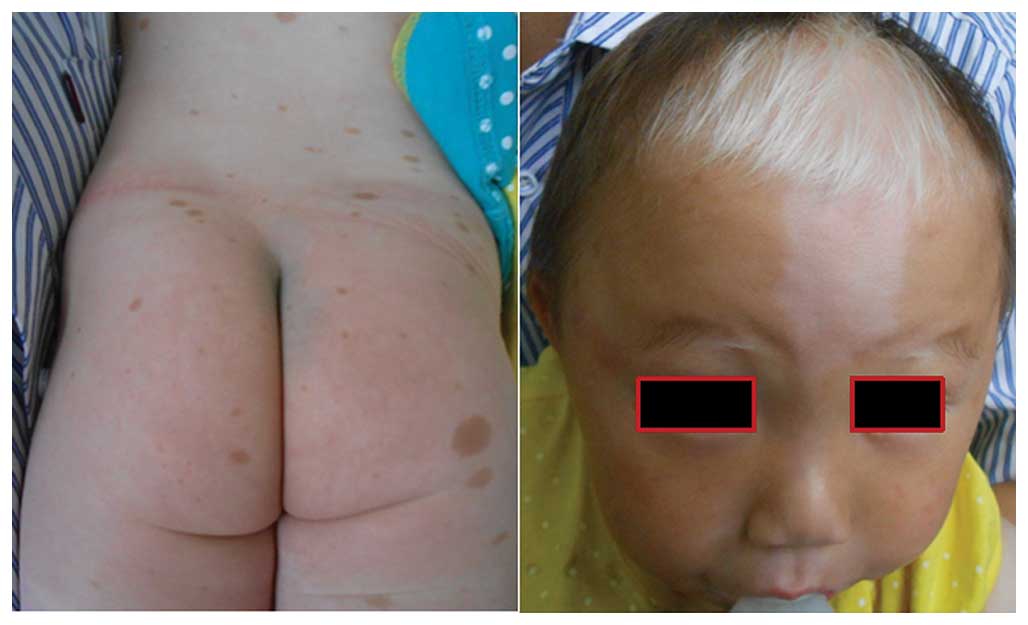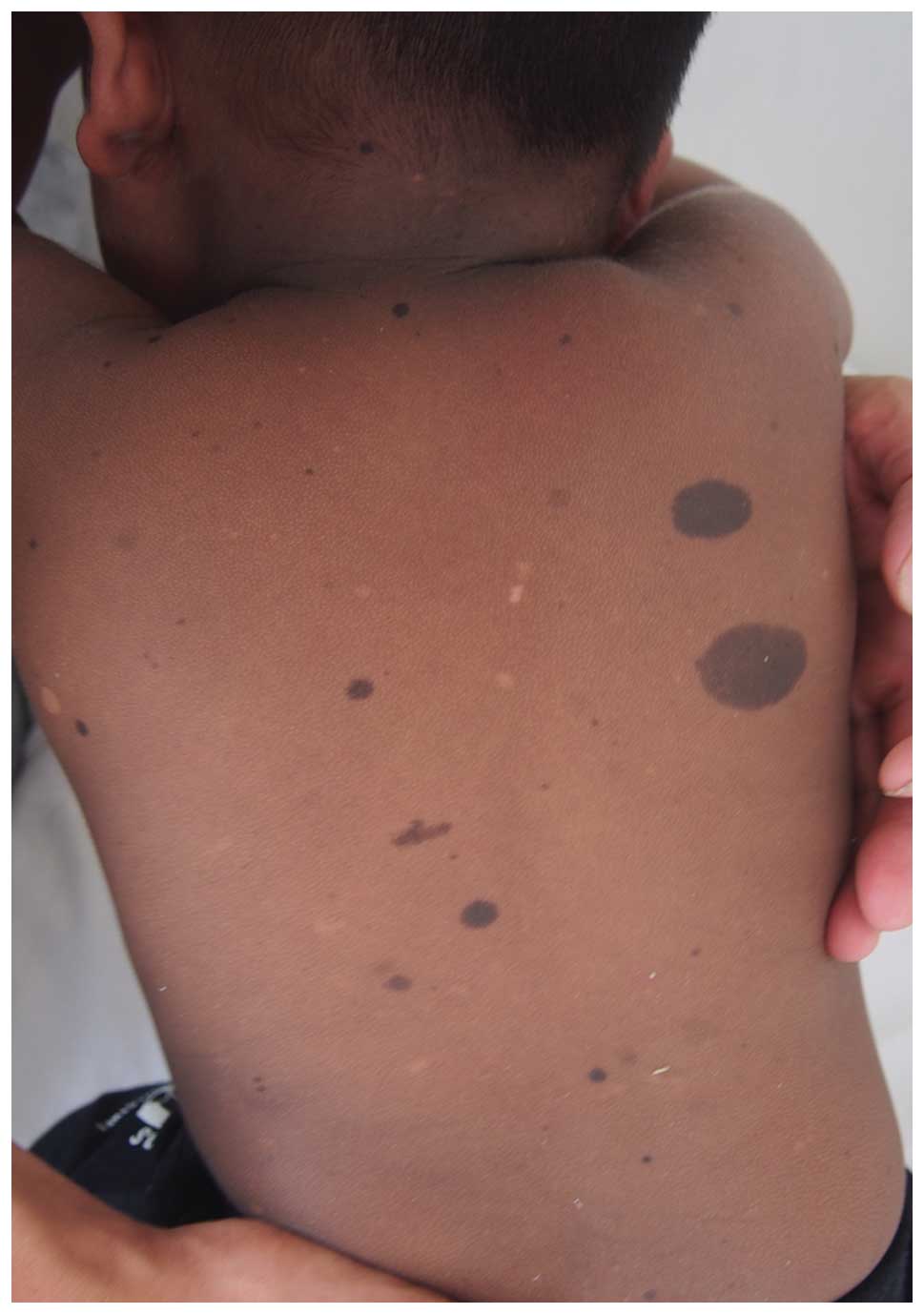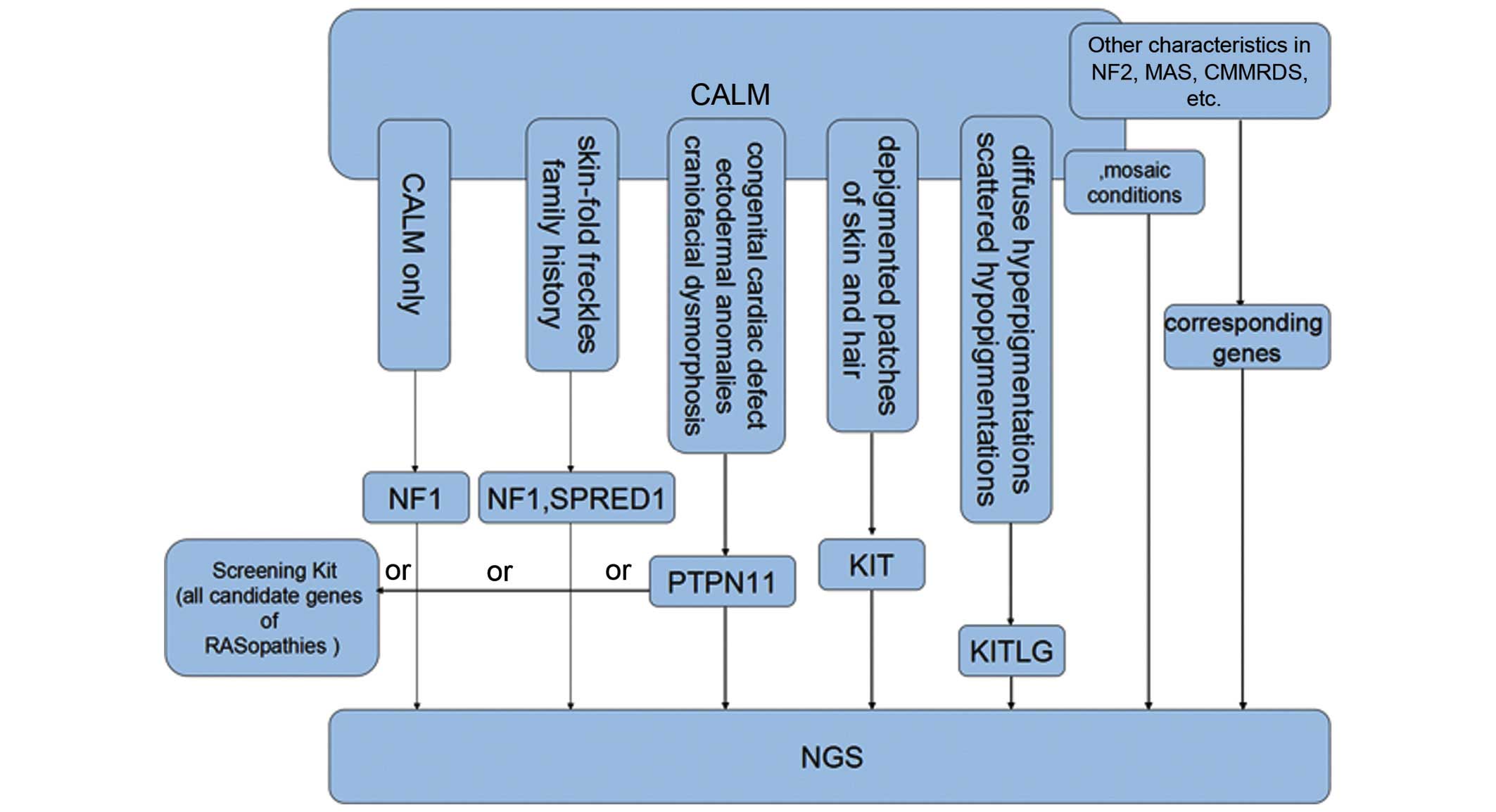Molecular screening strategies for NF1-like syndromes with café-au-lait macules (Review)
- Authors:
- Jia Zhang
- Ming Li
- Zhirong Yao
-
Affiliations: Department of Dermatology, Xinhua Hospital Affiliated to Shanghai Jiaotong University School of Medicine, Shanghai 200092, P.R. China - Published online on: September 22, 2016 https://doi.org/10.3892/mmr.2016.5760
- Pages: 4023-4029
-
Copyright: © Zhang et al. This is an open access article distributed under the terms of Creative Commons Attribution License.
This article is mentioned in:
Abstract
 |
 |
 |
|
Messiaen LM, Callens T, Mortier G, Beysen D, Vandenbroucke I, Van Roy N, Speleman F and Paepe AD: Exhaustive mutation analysis of the NF1 gene allows identification of 95% of mutations and reveals a high frequency of unusual splicing defects. Hum Mutat. 15:541–555. 2000. View Article : Google Scholar : PubMed/NCBI | |
|
Valero MC, Martin Y, Hernández-Imaz E, Marina Hernández A, Meleán G, Valero AM, Javier Rodríguez-Álvarez F, Tellería D and Hernández-Chico C: A highly sensitive genetic protocol to detect NF1 mutations. J Mol Diagn. 13:113–122. 2011. View Article : Google Scholar : PubMed/NCBI | |
|
Picardo M and Cardinali G: The genetic determination of skin pigmentation: KITLG and the KITLG/c-Kit pathway as key players in the onset of human familial pigmentary diseases. J Invest Dermatol. 131:1182–1185. 2011. View Article : Google Scholar : PubMed/NCBI | |
|
Zhang J, Tong H, Fu X, Zhang Y, Liu J, Cheng R, Liang J, Peng J, Sun Z, Liu H, et al: Molecular characterization of NF1 and neurofibromatosis type 1 genotype-phenotype correlations in a Chinese population. Sci Rep. 5:112912015. View Article : Google Scholar : PubMed/NCBI | |
|
Zhang J, Cheng R, Liang J, Ni C, Li M and Yao Z: Lentiginous phenotypes caused by diverse pathogenic genes (SASH1 and PTPN11): Clinical and molecular discrimination. Clin Genet. Feb 3–2016.Epub ahead of print. View Article : Google Scholar | |
|
Zhang J, Cheng R, Liang J, Ni C, Li M and Yao Z: Report of a sporadic familial progressive hyper- and hypopigmentation child caused by a novel KITLG mutation. Br J Dermatol. Apr 23–2016.Epub ahead of print. View Article : Google Scholar | |
|
Messiaen L, Yao S, Brems H, Callens T, Sathienkijkanchai A, Denayer E, Spencer E, Arn P, Babovic-Vuksanovic D, Bay C, et al: Clinical and mutational spectrum of neurofibromatosis type 1-like syndrome. JAMA. 302:2111–2118. 2009. View Article : Google Scholar : PubMed/NCBI | |
|
Brems H, Pasmant E, Van Minkelen R, Wimmer K, Upadhyaya M, Legius E and Messiaen L: Review and update of SPRED1 mutations causing Legius syndrome. Hum Mutat. 33:1538–1546. 2012. View Article : Google Scholar : PubMed/NCBI | |
|
Brems H and Legius E: Legius syndrome, an update. Molecular pathology of mutations in SPRED1. Keio J Med. 62:107–112. 2013. View Article : Google Scholar : PubMed/NCBI | |
|
[No authors lsited]: Neurofibromatosis. Conference statement. National Institutes of Health Consensus Development Conference, . Arch Neurol. 45:575–578. 1988. View Article : Google Scholar : PubMed/NCBI | |
|
Brems H, Chmara M, Sahbatou M, Denayer E, Taniguchi K, Kato R, Somers R, Messiaen L, De Schepper S, Fryns JP, et al: Germline loss-of-function mutations in SPRED1 cause a neurofibromatosis 1-like phenotype. Nat Genet. 39:1120–1126. 2007. View Article : Google Scholar : PubMed/NCBI | |
|
Pasmant E, Gilbert-Dussardier B, Petit A, de Laval B, Luscan A, Gruber A, Lapillonne H, Deswarte C, Goussard P, Laurendeau I, et al: SPRED1, a RAS MAPK pathway inhibitor that causes Legius syndrome, is a tumour suppressor downregulated in paediatric acute myeloblastic leukaemia. Oncogene. 34:631–638. 2015. View Article : Google Scholar : PubMed/NCBI | |
|
Pasmant E, Ballerini P, Lapillonne H, Perot C, Vidaud D, Leverger G and Landman-Parker J: SPRED1 disorder and predisposition to leukemia in children. Blood. 114:11312009. View Article : Google Scholar : PubMed/NCBI | |
|
Tartaglia M, Mehler EL, Goldberg R, Zampino G, Brunner HG, Kremer H, van der Burgt I, Crosby AH, Ion A, Jeffery S, et al: Mutations in PTPN11, encoding the protein tyrosine phosphatase SHP-2, cause Noonan syndrome. Nat Genet. 29:465–468. 2001. View Article : Google Scholar : PubMed/NCBI | |
|
Conti E, Dottorini T, Sarkozy A, Tiller GE, Esposito G, Pizzuti A and Dallapiccola B: A novel PTPN11 mutation in LEOPARD syndrome. Hum Mutat. 21:6542003. View Article : Google Scholar : PubMed/NCBI | |
|
Martínez-Quintana E and Rodríguez-González F: LEOPARD Syndrome: Clinical features and gene mutations. Mol Syndromol. 3:145–157. 2012.PubMed/NCBI | |
|
Wang Y, Chen C and Wang DW: Leopard syndrome caused by heterozygous missense mutation of Tyr 279 Cys in the PTPN11 gene in a sporadic case of Chinese Han. Int J Cardiol. 174:e101–e104. 2014. View Article : Google Scholar : PubMed/NCBI | |
|
Osawa R, Akiyama M, Yamanaka Y, Ujiie H, Nemoto-Hasebe I, Takeda A, Yanagi T and Shimizu H: A novel PTPN11 missense mutation in a patient with LEOPARD syndrome. Brit J Dermatol. 161:1202–1204. 2009. View Article : Google Scholar | |
|
Digilio MC, Conti E, Sarkozy A, Mingarelli R, Dottorini T, Marino B, Pizzuti A and Dallapiccola B: Grouping of multiple-lentigines/LEOPARD and Noonan syndromes on the PTPN11 gene. Am J Hum Genet. 71:389–394. 2002. View Article : Google Scholar : PubMed/NCBI | |
|
Yoshida R, Hasegawa T, Hasegawa Y, Nagai T, Kinoshita E, Tanaka Y, Kanegane H, Ohyama K, Onishi T, Hanew K, et al: Protein-tyrosine phosphatase, nonreceptor type 11 mutation analysis and clinical assessment in 45 patients with Noonan syndrome. J Clin Endocrinol Metab. 89:3359–3364. 2004. View Article : Google Scholar : PubMed/NCBI | |
|
Tartaglia M, Martinelli S, Stella L, Bocchinfuso G, Flex E, Cordeddu V, Zampino G, Burgt Iv, Palleschi A, Petrucci TC, et al: Diversity and functional consequences of germline and somatic PTPN11 mutations in human disease. Am J Hum Genet. 78:279–290. 2006. View Article : Google Scholar : PubMed/NCBI | |
|
Kontaridis MI, Swanson KD, David FS, Barford D and Neel BG: PTPN11 (Shp2) mutations in LEOPARD syndrome have dominant negative, not activating, effects. J Biol Chem. 281:6785–6792. 2006. View Article : Google Scholar : PubMed/NCBI | |
|
Motegi S, Yokoyama Y, Ogino S, Yamada K, Uchiyama A, Perera B, Takeuchi Y, Ohnishi H and Ishikawa O: Pathogenesis of multiple lentigines in LEOPARD syndrome with PTPN11 gene mutation. Acta Derm Venereol. 95:978–984. 2015. View Article : Google Scholar : PubMed/NCBI | |
|
Nishi E, Mizuno S, Nanjo Y, Niihori T, Fukushima Y, Matsubara Y, Aoki Y and Kosho T: A novel heterozygous MAP2K1 mutation in a patient with Noonan syndrome with multiple lentigines. Am J Med Genet A 167A. 407–411. 2015. View Article : Google Scholar | |
|
Nava C, Hanna N, Michot C, Pereira S, Pouvreau N, Niihori T, Aoki Y, Matsubara Y, Arveiler B, Lacombe D, et al: Cardio-facio-cutaneous and Noonan syndromes due to mutations in the RAS/MAPK signalling pathway: Genotype-phenotype relationships and overlap with Costello syndrome. J Med Genet. 44:763–771. 2007. View Article : Google Scholar : PubMed/NCBI | |
|
Allanson JE: Noonan syndrome. J Med Genet. 24:9–13. 1987. View Article : Google Scholar : PubMed/NCBI | |
|
Digilio MC, Sarkozy A, de Zorzi A, Pacileo G, Limongelli G, Mingarelli R, Calabrò R, Marino B and Dallapiccola B: LEOPARD syndrome: Clinical diagnosis in the first year of life. Am J Med Genet A. 140:740–746. 2006. View Article : Google Scholar : PubMed/NCBI | |
|
Carcavilla A, Pinto I, Muñoz-Pacheco R, Barrio R, Martin-Frias M and Ezquieta B: LEOPARD syndrome (PTPN11, T468 M) in three boys fulfilling neurofibromatosis type 1 clinical criteria. Eur J Pediatr. 170:1069–1074. 2011. View Article : Google Scholar : PubMed/NCBI | |
|
Tartaglia M, Niemeyer CM, Fragale A, Song X, Buechner J, Jung A, Hählen K, Hasle H, Licht JD and Gelb BD: Somatic mutations in PTPN11 in juvenile myelomonocytic leukemia, myelodysplastic syndromes and acute myeloid leukemia. Nat Genet. 34:148–150. 2003. View Article : Google Scholar : PubMed/NCBI | |
|
Rankin J, Short J, Turnpenny P, Castle B and Hanemann CO: Medulloblastoma in a patient with the PTPN11 p.Thr468Met mutation. Am J Med Genet A 161A. 2027–2029. 2013. View Article : Google Scholar | |
|
Hennekam RC: Costello syndrome: An overview. Am J Med Genet Part C Semin Med Genet 117C. 42–48. 2003. View Article : Google Scholar | |
|
Bryan ZT, Missall TA, Stieren S, Siegfried E and Burkemper NM: Clinicopathologic evaluation of cardiofaciocutaneous syndrome: Overcoming the challenges of diagnosing a rare genodermatosis. Pediatr Dermatol. 32:e23–e28. 2015. View Article : Google Scholar : PubMed/NCBI | |
|
Alper J, Holmes LB and Mihm MC Jr: Birthmarks with serious medical significance: Nevocellular nevi, sebaceous nevi, and multiple café au lait spots. J Pediatr. 95:696–700. 1979. View Article : Google Scholar : PubMed/NCBI | |
|
Siegel DH, McKenzie J, Frieden IJ and Rauen KA: Dermatological findings in 61 mutation-positive individuals with cardiofaciocutaneous syndrome. Brit J Dermatol. 164:521–529. 2011. | |
|
Zenker M, Lehmann K, Schulz AL, Barth H, Hansmann D, Koenig R, Korinthenberg R, Kreiss-Nachtsheim M, Meinecke P, Morlot S, et al: Expansion of the genotypic and phenotypic spectrum in patients with KRAS germline mutations. J Med Genet. 44:131–135. 2007. View Article : Google Scholar : PubMed/NCBI | |
|
Fryer AE, Holt PJ and Hughes HE: The cardio-facio-cutaneous (CFC) syndrome and Noonan syndrome: Are they the same? Am J Med Genet. 38:548–551. 1991. View Article : Google Scholar : PubMed/NCBI | |
|
Tidyman WE and Rauen KA: Noonan, Costello and cardio-facio-cutaneous syndromes: Dysregulation of the Ras-MAPK pathway. Expert Rev Mol Med. 10:e372008. View Article : Google Scholar : PubMed/NCBI | |
|
Bertola DR, Pereira AC, Brasil AS, Albano LM, Kim CA and Krieger JE: Further evidence of genetic heterogeneity in Costello syndrome: Involvement of the KRAS gene. J Hum Genet. 52:521–526. 2007. View Article : Google Scholar : PubMed/NCBI | |
|
Niihori T, Aoki Y, Narumi Y, Neri G, Cavé H, Verloes A, Okamoto N, Hennekam RC, Gillessen-Kaesbach G, Wieczorek D, et al: Germline KRAS and BRAF mutations in cardio-facio-cutaneous syndrome. Nat Genet. 38:294–296. 2006. View Article : Google Scholar : PubMed/NCBI | |
|
Schubbert S, Zenker M, Rowe SL, Böll S, Klein C, Bollag G, van der Burgt I, Musante L, Kalscheuer V, Wehner LE, et al: Germline KRAS mutations cause Noonan syndrome. Nat Genet. 38:331–336. 2006. View Article : Google Scholar : PubMed/NCBI | |
|
Abe Y, Aoki Y, Kuriyama S, Kawame H, Okamoto N, Kurosawa K, Ohashi H, Mizuno S, Ogata T, Kure S, et al: Prevalence and clinical features of Costello syndrome and cardio-facio-cutaneous syndrome in Japan: Findings from a nationwide epidemiological survey. Am J Med Genet A 158A. 1083–1094. 2012. View Article : Google Scholar | |
|
Sarkozy A, Carta C, Moretti S, Zampino G, Digilio MC, Pantaleoni F, Scioletti AP, Esposito G, Cordeddu V, Lepri F, et al: Germline BRAF mutations in Noonan, LEOPARD, and cardiofaciocutaneous syndromes: Molecular diversity and associated phenotypic spectrum. Hum Mutat. 30:695–702. 2009. View Article : Google Scholar : PubMed/NCBI | |
|
Neri G and Zollino M: More on the Noonan-CFC controversy. Am J Med Genet. 65:1001996. View Article : Google Scholar : PubMed/NCBI | |
|
De Luca A, Bottillo I, Sarkozy A, Carta C, Neri C, Bellacchio E, Schirinzi A, Conti E, Zampino G, Battaglia A, et al: NF1 gene mutations represent the major molecular event underlying neurofibromatosis-Noonan syndrome. Am J Hum Genet. 77:1092–1101. 2005. View Article : Google Scholar : PubMed/NCBI | |
|
Watson GH: Pulmonary stenosis, café-au-lait spots, and dull intelligence. Arch Dis Child. 42:303–307. 1967. View Article : Google Scholar : PubMed/NCBI | |
|
Allanson JE, Upadhyaya M, Watson GH, Partington M, MacKenzie A, Lahey D, MacLeod H, Sarfarazi M, Broadhead W, Harper PS, et al: Watson syndrome: Is it a subtype of type 1 neurofibromatosis? J Med Genet. 28:752–756. 1991. View Article : Google Scholar : PubMed/NCBI | |
|
Upadhyaya M, Shen M, Cherryson A, Farnham J, Maynard J, Huson SM and Harper PS: Analysis of mutations at the neurofibromatosis 1 (NF1) locus. Hum Mol Genet. 1:735–740. 1992. View Article : Google Scholar : PubMed/NCBI | |
|
Tassabehji M, Strachan T, Sharland M, Colley A, Donnai D, Harris R and Thakker N: Tandem duplication within a neurofibromatosis type 1 (NF1) gene exon in a family with features of Watson syndrome and Noonan syndrome. Am J Hum Genet. 53:90–95. 1993.PubMed/NCBI | |
|
Thiel C, Wilken M, Zenker M, Sticht H, Fahsold R, Gusek-Schneider GC and Rauch A: Independent NF1 and PTPN11 mutations in a family with neurofibromatosis-Noonan syndrome. Am J Med Genet A 149A. 1263–1267. 2009. View Article : Google Scholar | |
|
Nyström AM, Ekvall S, Strömberg B, Holmström G, Thuresson AC, Annerén G and Bondeson ML: A severe form of Noonan syndrome and autosomal dominant café-au-lait spots-evidence for different genetic origins. Acta Paediatr. 98:693–698. 2009. View Article : Google Scholar : PubMed/NCBI | |
|
Spritz RA, Itin PH and Gutmann DH: Piebaldism and neurofibromatosis type 1: Horses of very different colors. J Invest Dermatol. 122:xxxiv–xxxv. 2004. View Article : Google Scholar : PubMed/NCBI | |
|
Duarte AF, Mota A, Baudrier T, Morais P, Santos A, Cerqueira R, Tavares P and Azevedo F: Piebaldism and neurofibromatosis type 1: Family report. Dermatol Online J. 16:112010.PubMed/NCBI | |
|
Chiu YE, Dugan S, Basel D and Siegel DH: Association of Piebaldism, multiple café-au-lait macules, and intertriginous freckling: Clinical evidence of a common pathway between KIT and sprouty-related, ena/vasodilator-stimulated phosphoprotein homology-1 domain containing protein 1 (SPRED1). Pediatr Dermatol. 30:379–382. 2013. View Article : Google Scholar : PubMed/NCBI | |
|
Amyere M, Vogt T, Hoo J, Brandrup F, Bygum A, Boon L and Vikkula M: KITLG mutations cause familial progressive hyper- and hypopigmentation. J Invest Dermatol. 131:1234–1239. 2011. View Article : Google Scholar : PubMed/NCBI | |
|
Oiso N, Fukai K, Kawada A and Suzuki T: Piebaldism. J Dermatol. 40:330–335. 2013. View Article : Google Scholar : PubMed/NCBI | |
|
Spritz RA: Molecular basis of human piebaldism. J Invest Dermatol. 103:(Suppl 5). S137–S140. 1994. View Article : Google Scholar | |
|
Angelo C, Cianchini G, Grosso MG, Zambruno G, Cavalieri R and Paradisi M: Association of piebaldism and neurofibromatosis type 1 in a girl. Pediatr Dermatol. 18:490–493. 2001. View Article : Google Scholar : PubMed/NCBI | |
|
Duarte A, Mota A, Baudrier T, Morais P, Santos A, Cerqueira R, Tavares P and Azevedo F: Piebaldism and neurofibromatosis: State of knowledge. Dermatol Online J. 19:172013.PubMed/NCBI | |
|
Wang ZQ, Si L, Tang Q, Lin D, Fu Z, Zhang J, Cui B, Zhu Y, Kong X, Deng M, et al: Gain-of-function mutation of KIT ligand on melanin synthesis causes familial progressive hyperpigmentation. Am J Hum Genet. 84:672–677. 2009. View Article : Google Scholar : PubMed/NCBI | |
|
Betz RC, Planko L, Eigelshoven S, Hanneken S, Pasternack SM, Bussow H, Van Den Bogaert K, Wenzel J, Braun-Falco M, Rutten A, et al: Loss-of-function mutations in the keratin 5 gene lead to Dowling-Degos disease. Am J Hum Genet. 78:510–519. 2006. View Article : Google Scholar : PubMed/NCBI | |
|
Pickup TL and Mutasim DF: Dowling-Degos disease presenting as hypopigmented macules. J Am Acad Dermatol. 64:1224–1225. 2011. View Article : Google Scholar : PubMed/NCBI | |
|
Li M, Cheng R, Liang J, Yan H, Zhang H, Yang L, Li C, Jiao Q, Lu Z, He J, et al: Mutations in POFUT1, encoding protein O-fucosyltransferase 1, cause generalized Dowling-Degos disease. Am J Hum Genet. 92:895–903. 2013. View Article : Google Scholar : PubMed/NCBI | |
|
Basmanav FB, Oprisoreanu AM, Pasternack SM, Thiele H, Fritz G, Wenzel J, Größer L, Wehner M, Wolf S, Fagerberg C, et al: Mutations in POGLUT1, encoding protein O-glucosyltransferase 1, cause autosomal-dominant Dowling-Degos disease. Am J Hum Genet. 94:135–143. 2014. View Article : Google Scholar : PubMed/NCBI | |
|
Pérez B, Mechinaud F, Galambrun C, Ben Romdhane N, Isidor B, Philip N, Derain-Court J, Cassinat B, Lachenaud J, Kaltenbach S, et al: Germline mutations of the CBL gene define a new genetic syndrome with predisposition to juvenile myelomonocytic leukaemia. J Med Genet. 47:686–691. 2010. View Article : Google Scholar : PubMed/NCBI | |
|
Aoki Y, Niihori T, Banjo T, Okamoto N, Mizuno S, Kurosawa K, Ogata T, Takada F, Yano M, Ando T, et al: Gain-of-function mutations in RIT1 cause Noonan syndrome, a RAS/MAPK pathway syndrome. Am J Hum Genet. 93:173–180. 2013. View Article : Google Scholar : PubMed/NCBI | |
|
Shah KN: The diagnostic and clinical significance of café-au-lait macules. Pediatr Clin North Am. 57:1131–1153. 2010. View Article : Google Scholar : PubMed/NCBI |









